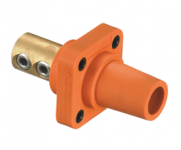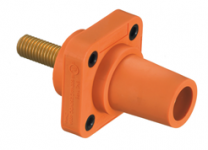Sra328
Member
- Location
- New England
- Occupation
- Electrician
TLDR; need to feed 400A camlock connectors from 400A breaker, being told 4/0 flexible "welding" cable is acceptable, need supporting information and potential solutions/suggestions on best means and methods to achieve these connections. I am assuming regular copper conductors will be necessary.
Context:
I have been tasked with providing a 400A camlock cabinet whos function is to allow portable equipment to be wheeled up/plugged in as needed. To be fed from an existing 400A breaker in a distribution panelboard located in a parking lot.
The issue I run into: There is an engineer for the project who has advised us to use a 4/0 type W cable rated at 405A. I know a flexible cord/cable can not be installed in conduit/as permanent wiring. Set screw camlocks (hubbell pictured) can accomodate #4-4/0, however if the 400A wiring feeding these is required to be in conduit, I can not find any supporting code articles that would allow me to install a 4/0 from the breaker, through conduit nipple, into the hinged cabinet that would receive the female camlock connectors.

What I am looking for assistance with:
(1) conductor sizing. I am assuming i will need to use 500Kcmil CU conductors and hypress either a pin adapter (probably not best practice) or a 90* 1 hole lug to utilize the threaded post style that is pictured below . I have seen Storm switch/Trystar cabinets with 400A CB's that connect to the cam lock connections were fed with 4/0 THHN's, which is a similar install to my situation (other than pulling power from my camlocks, rather than providing power to the camlocks as is typical with generator docking stations). Is there any code articles/exceptions that would allow me to provide 4/0 CU flexible cable to my camlocks, for a 400A feeder. (i am 98% confident the answer is no).
If anyone has any insight this would be much appreciated.

Context:
I have been tasked with providing a 400A camlock cabinet whos function is to allow portable equipment to be wheeled up/plugged in as needed. To be fed from an existing 400A breaker in a distribution panelboard located in a parking lot.
The issue I run into: There is an engineer for the project who has advised us to use a 4/0 type W cable rated at 405A. I know a flexible cord/cable can not be installed in conduit/as permanent wiring. Set screw camlocks (hubbell pictured) can accomodate #4-4/0, however if the 400A wiring feeding these is required to be in conduit, I can not find any supporting code articles that would allow me to install a 4/0 from the breaker, through conduit nipple, into the hinged cabinet that would receive the female camlock connectors.

What I am looking for assistance with:
(1) conductor sizing. I am assuming i will need to use 500Kcmil CU conductors and hypress either a pin adapter (probably not best practice) or a 90* 1 hole lug to utilize the threaded post style that is pictured below . I have seen Storm switch/Trystar cabinets with 400A CB's that connect to the cam lock connections were fed with 4/0 THHN's, which is a similar install to my situation (other than pulling power from my camlocks, rather than providing power to the camlocks as is typical with generator docking stations). Is there any code articles/exceptions that would allow me to provide 4/0 CU flexible cable to my camlocks, for a 400A feeder. (i am 98% confident the answer is no).
If anyone has any insight this would be much appreciated.


